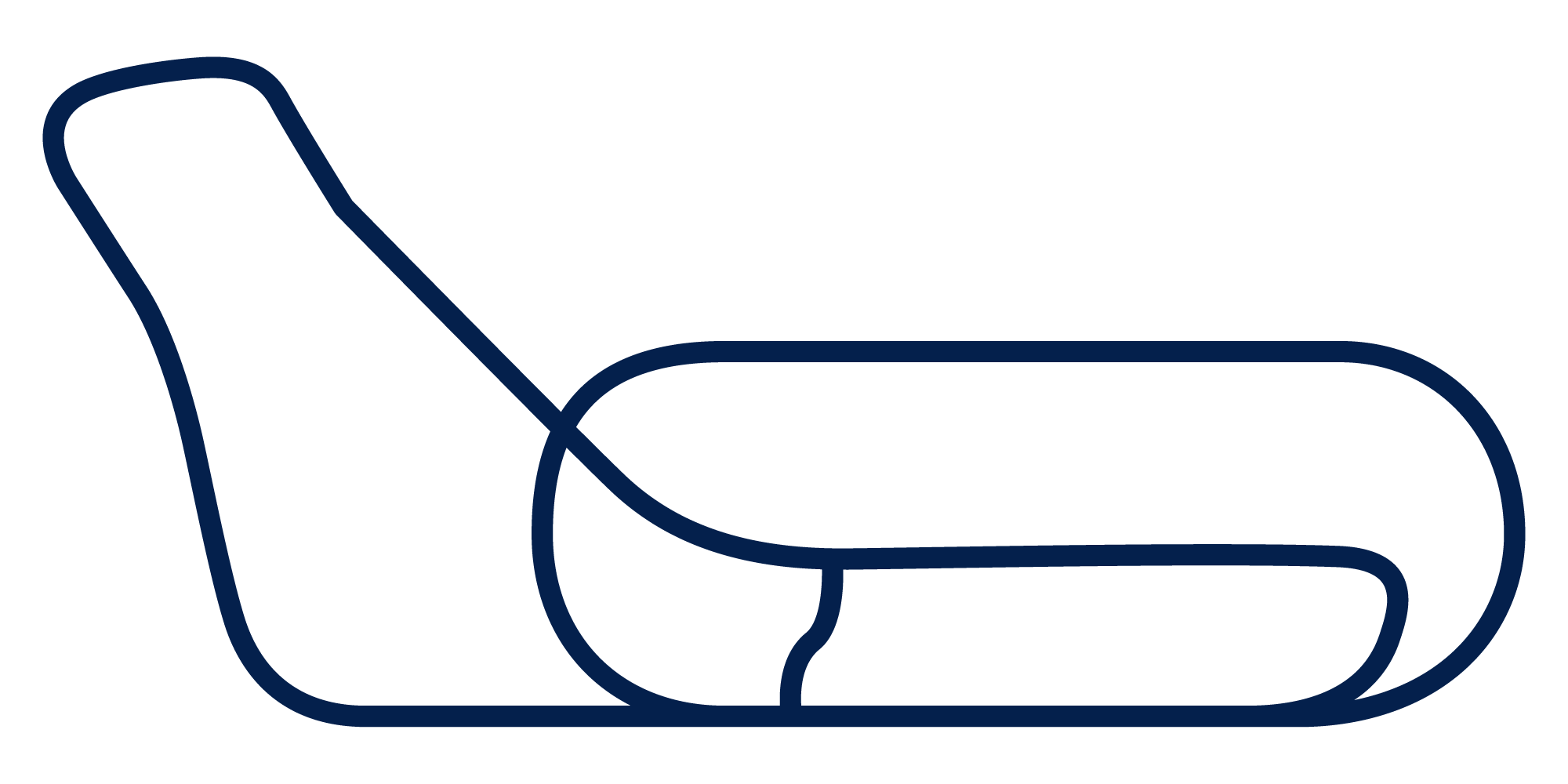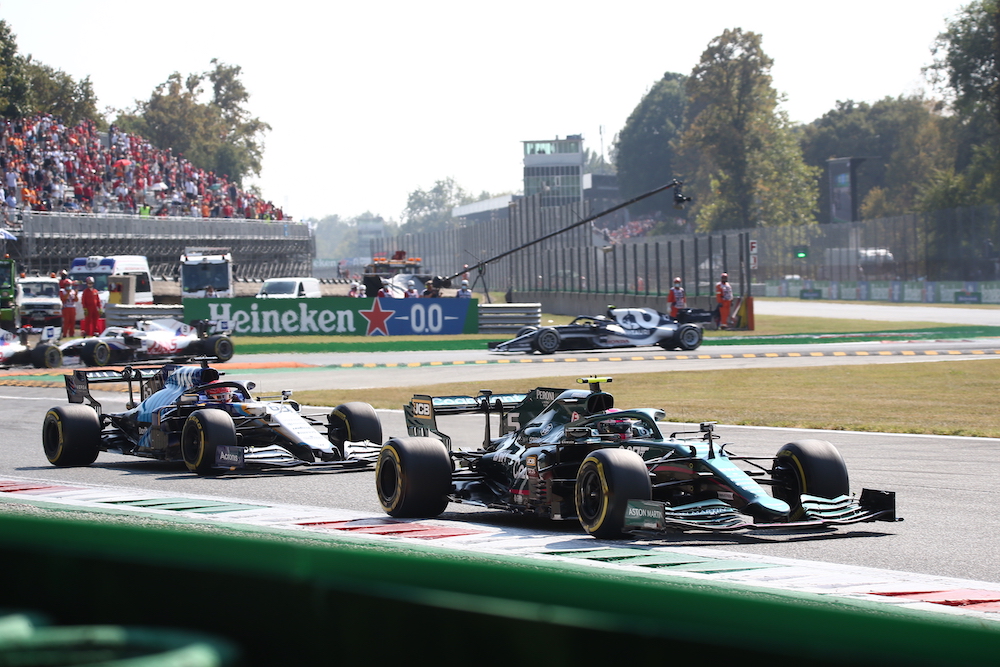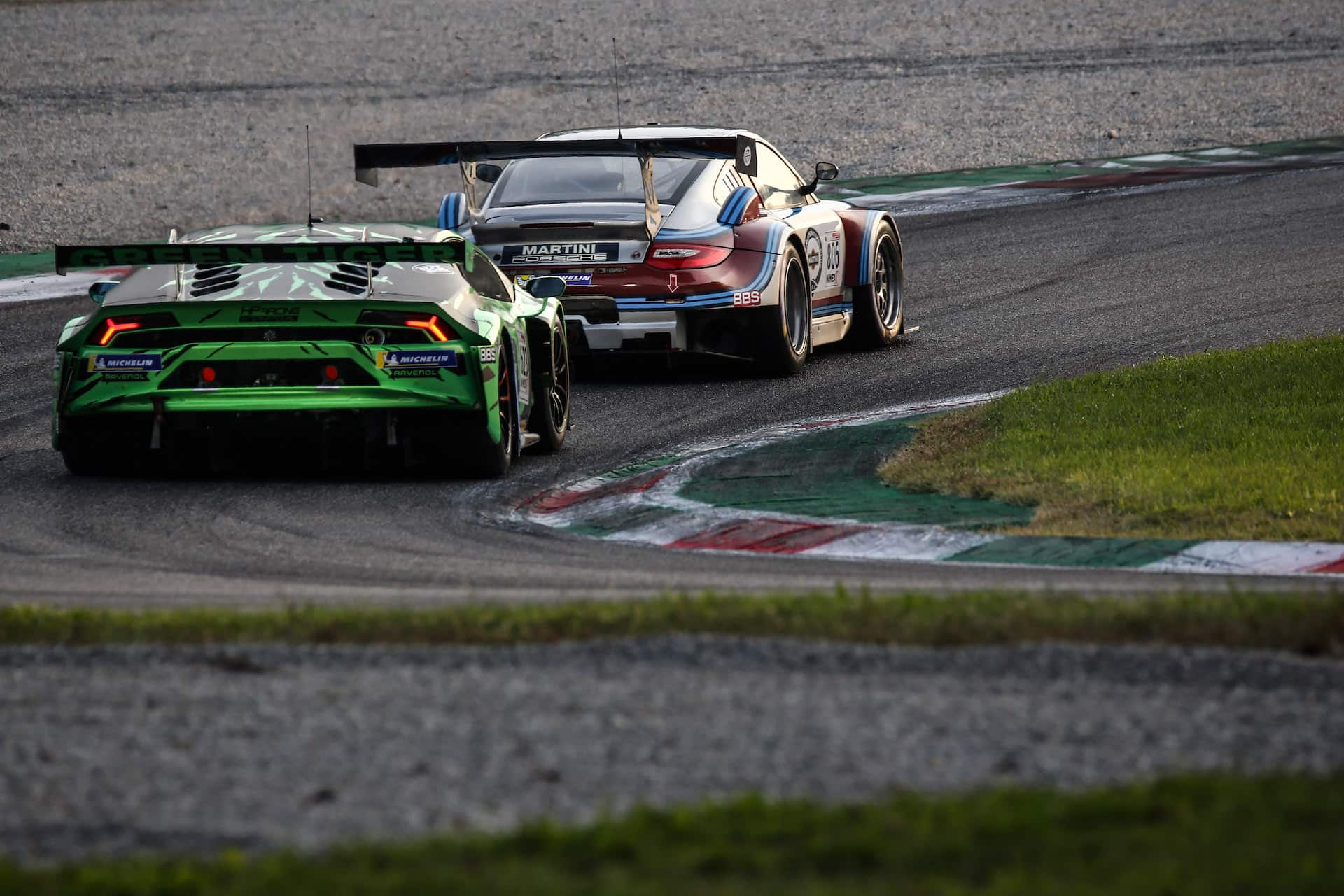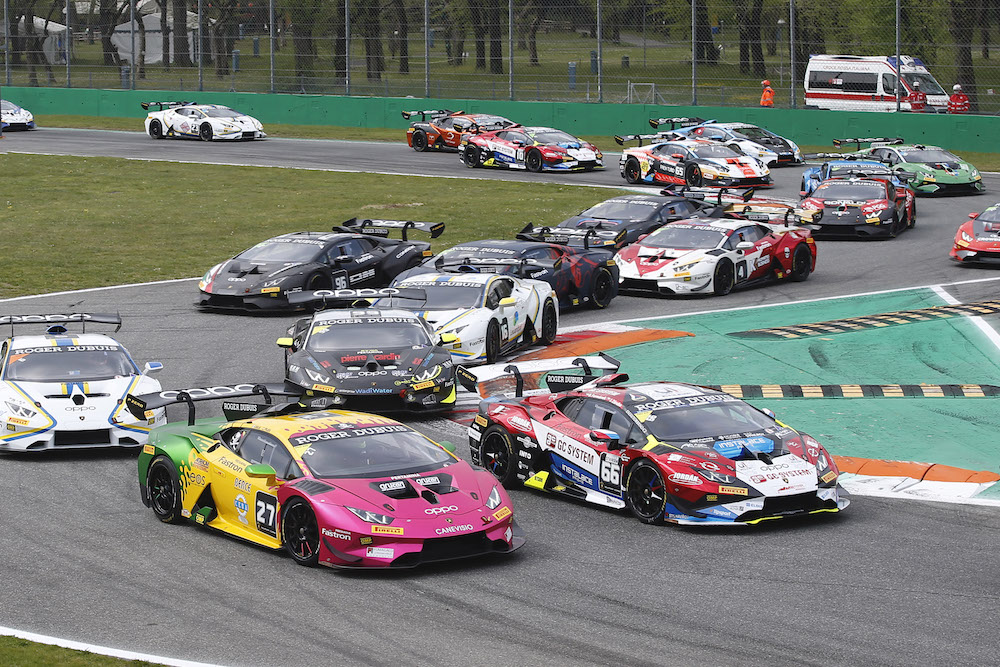The circuit
The layout of the Monza circuit
From 1922 to today, the Autodromo Nazionale Monza circuit has seen many transformations that have led to the configuration of the current track .
- Length : 5793 meters
- Width : min 10 m. – max 12 m.
- Coordinates (latitude and longitude) : 45 ° 37’06 “N – 9 ° 16’54” E
- Direction of travel : clockwise
- Maximum speed : The absolute speed record in Formula 1 was set in Monza in 2005, by Kimi Räikkönen on Mclaren with 370.1 km / h
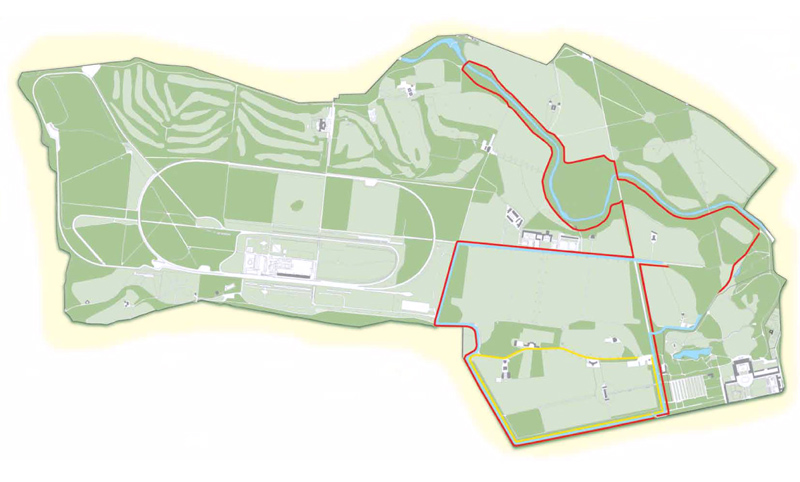
The First Variant (or Variante del Rettifilo)
In order to increase the selection in the race, in 1972 a chicane was built at the height of the junior variant , to reduce the speed of entry into the following Biassono curve . In 1976, it became a variant formed by the succession of two left and two right curves , in order to further lower the speeds. Another change occurred in 2000 when it was redesigned with a sharp right-hand bend, which breaks the long finish straight, and then joins towards the next hairpin.
The Prima Variante or Variante del Rettifilo therefore presents itself as a very tight right bend of 90 degrees , followed by an equally tight left elbow bend . From the straight of the pits you get launched at over 370 km / h and, with a very long braking, you decelerate to just 70-80 km / h to face this “esse”.
Historical Notes
At the bottleneck that precedes the 1st variant, there is a dramatic carom involving numerous cars. To have the worst are Vittorio Brambilla and Ronnie Peterson, who will lose their lives in hospital due to gas embolism.
Ayrton Senna’s triumphal march runs aground on the escape route, after the contact with the dubbed Jean Louis Schlesser.
The leader Mika Hakkinen interrupts his escape ending up in the tail. Embittered by the mistake made, the Finn indulges in tears, immortalized by the media.
Biassono curve
The wide radius and its length originally earned it the name of Curva Grande, but in 1972 it was renamed Curva Biassono due to its proximity to the town of the same name. It is a long curve to the right with a radius of about 300 meters which can be reached in full acceleration from the First Variante and followed in full with a good dose of courage.
Historical Notes
Gerhard Berger ends up ko due to a camera detached from the Ferrari of his teammate Jean Alesi. Victory for the Austrian and a lot of fear.
Second variant (or variant of the canal)
Born as Curva della Roggia, due to a small stream that rose nearby, its design was modified in 1976, to reduce the ever-higher averages. Thus it became the Second Variante or Variante della Roggia . It too is located at the end of a long straight (over 1 km with the accelerator at the bottom, including the Biassono curve) on which you reach 335 km / h. With a very long braking, you decelerate to 110-120 km / h to face a very narrow left-right “S” , modified in 2000.
Historical Notes
Sparks between Damon Hill and Michael Schumacher. The world championship fight between the two ends in sand after the collision by the Englishman. Released from his Benetton, Schumi lashes out at his rival, but is stopped by a commissioner.
On the first lap several cars are involved in a bad accident, the pieces of which fly everywhere. One of these will be fatal for a runway firefighting volunteer.
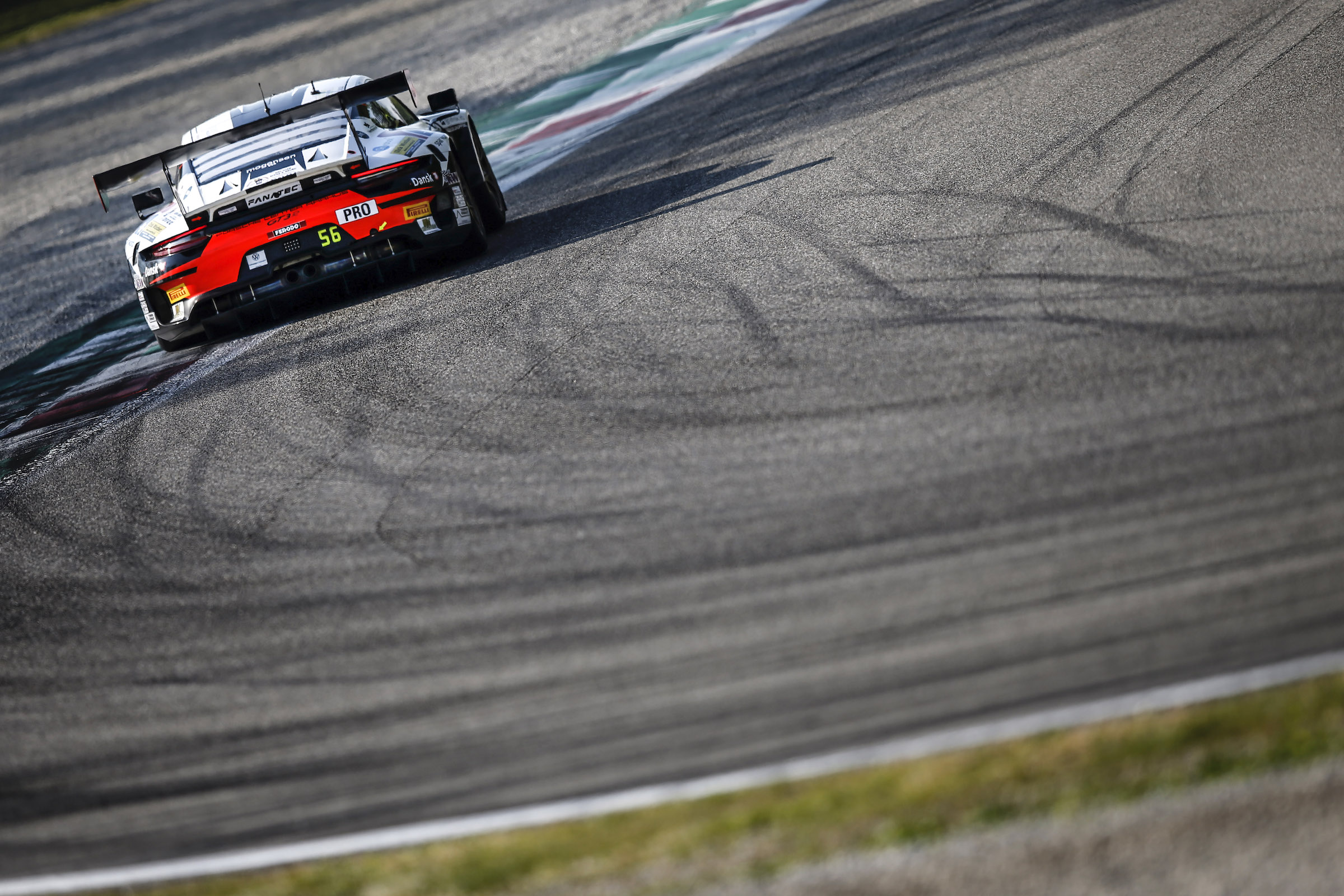
First Lesmo Curve
Surrounded by the woods, it was originally the Curva delle Querce . Then, from the chronicles of ’27, we learn that it changed its name to Curvetta di Lesmo , given its short length and location near the town. Located just 200 meters from the exit of the Second Variant , it can be reached at not too high speeds and it is a right-hand bend with a radius of 75 meters that runs at about 180 km / h.
Historical Notes
An attacking Chris Amon collides with John Surtees’ Honda due to an oil stain. The Ferrarista flies over the barriers and lands in the woods, fortunately unharmed.
Bitter Grand Prix for Lewis Hamilton, after the pole position the day before. In an attempt to regain 2nd place, the Englishman forced the pace in the final and at 52nd of the 53 laps he took control of his McLaren-Mercedes, crashing into the barriers at the exit of the 1st Lesmo curve. No physical consequences, but a lot of disappointment for the outgoing World Champion.
Second Lesmo Curve
Located 200 meters from the First Curve of Lesmo, the Second Curva of Lesmo is also located among the thick vegetation. In 1922 it was known as the Curva dei 100 Metri , due to the distance that separated the entry point from the exit point, while in 1927 it became the Curva del bosco dei Cervi . The park, in fact, was populated by a varied fauna. Only later did it finally take on its current name.
In the past, it was one of the mythical points of the circuit: you would arrive there at full acceleration and enter the curve at almost 300 km/h. Only the best drivers were able to cover it in full. With the modifications of 1994-95 it was slowed down a lot and today it has only 35 meters of radius and runs at around 160 km / h .
Historical Notes
In the positioning lap before the second start, Jody Scheckter loses control of his Wolf and crashes into the barriers. The accident will cause a further delay in the repair of the guard rail. The start will thus be given at 6.15 pm, with a consequent reduction of the race to 40 laps due to the drop in light.
Curva del Serraglio
The name of the curve derives from the presence in the immediate vicinity of the Seraglio. It was the King’s hunting lodge, where animals were also kept. It is a very slight left bend with an extremely wide radius of over 600 meters. The next straight crosses, with an underpass, the North bank curve of the high-speed loop.
Historical Notes
Fear of John Watson who, lost control, destroys his McLaren against the barriers. The consequences are a conspicuous flare-up, the car split in two, but the driver unharmed.
Ascari variant
Originally it was called Curva del Platano or del Vialone, because it passed over the large access road to the Autodrome. From 1955 it changes its name and is dedicated to Alberto Ascari . The reason brings us back to May 26 of that same year. While completing a few laps with a Ferrari Sport, the Milanese champion loses his life due to an off road at that point. To slow down the high speeds, in 1972 a chicane was built at the entry point which two years later was further modified in terms of width and in the exit stretch, thus taking on the definitive name of variant. You can get there by holding down the accelerator from the second of Lesmo and even here you reach 330 km / h . After braking, three left-right-left curves face in rapid succession, leading to the straight opposite the pits. They are curves with a fairly wide radius that are traveled at speeds of around 200 km / h.
Historical Notes
During a private practice session in view of the Monza Mille Kilometer, Alberto Ascari gets into Eugenio Castellotti’s Ferrari Sport, to take some steps. Unfortunately, a tragic exit from the track near the corner that will be dedicated to him will be fatal.
Bang once the tests are over. The two Ferraris were the protagonists on the return lap. Thanks to a misunderstanding with his mate Jean Alesi, Gerhard Berger flies off the track at the braking point of the Ascari variant, crashing into the tire wall at 327 km / h. So much fear, but fortunately the pilot is unharmed.
After signing pole position, the young David Coulthard spoils everything in the reconnaissance lap. At the Ascari variant, it ends up in sand, but thanks to a red flag exposed due to an accident on the 1st lap, it restarts at the 2nd start. It will end up in sand again on lap 13, raising the white flag.
During the 3rd free practice session on Saturday morning, Kimi Raikkonen loses control of his F2007 and crashes into the tire wall at the entrance to the Variante Ascari. The bang is terrible, but luckily the Finn comes out just a little bruised.
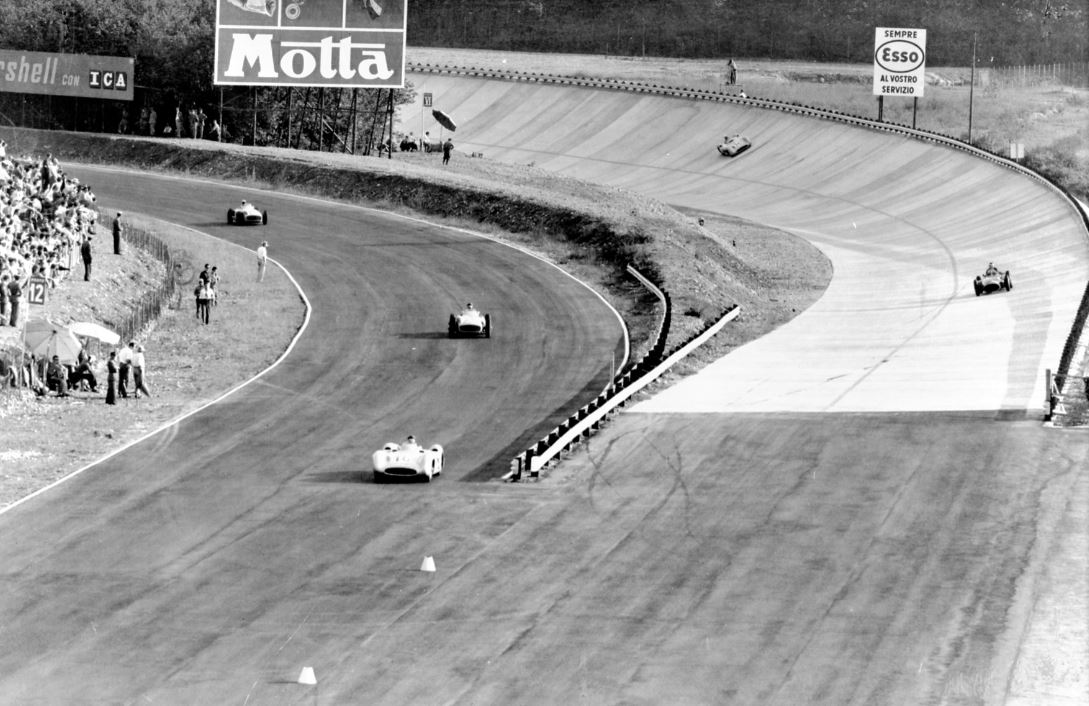
Alboreto Curve (Parabolic)
In the year of construction of the plant, there is no trace of a precise name, we only speak of Curvetta. In 1927 they began to be called Curvette. In reality, they were two hairpin bends characterized by a radius of 60 meters and an amplitude of 90 °, joined by a very short straight line. Given the particularity of the pavement, made up of many porphyry cubes, it became famous for being the Curva del Porfido. Rebuilt in 1955 , when the track returned to its original setting, it was called the Parabolic Curve for the design and the trajectory it described.
On the straight that leads to this corner, you hit 330 km / h again, then you brake to enter the curve at around 180 km / h. The curve is very long and with a gradually increasing radius : after passing the narrowest part, the final stretch can be covered in full acceleration, sliding outwards and taking the finish straight at already very high speeds.
Historical Notes
At the last lap, Alberto Ascari leads in front of Fangio and Farina. But at the Parabolic Curve the leader ends up at the head of the queue, thanks to the presence of two lapped. The accident thus eliminated Ascari’s Ferrari and made Farina lose positions, giving the green light to Fangio for his first triumph at Monza.
During qualifying on Saturday, Jochen Rindt’s Lotus went off the track at the entrance to the Parabolica due to a mechanical failure. A fatal crash for the Austrian driver, who has just been crowned World Champion and who will be awarded the posthumous title.
At the end of the first lap, Derek Warwick’s Lotus crashes into the guard rail at the exit of the Parabolica. The car rolls over and ends its crazy overturned race. The fear vanishes when the Englishman immediately emerges unscathed from the wreckage and rushes to the pits to get into the reserve car and line up for the second start, after having passed the medical checks.
Starting
The starting straight line runs from the end of the Parabolic Curve to the beginning of the First Variant and is 1194.40 meters long.
Historical Notes
As he passes a Bugatti, Emilio Materassi goes off the track, causing victims and injuries among the spectators.
Five single-seaters enclosed in one second will compete for the sprint victory. Gethin wins on BRM
A few meters from the finish line, Christian Fittipaldi’s Minardi takes off after hitting his mate Martini. It does some loops and lands on the 4 four wheels, without consequences.
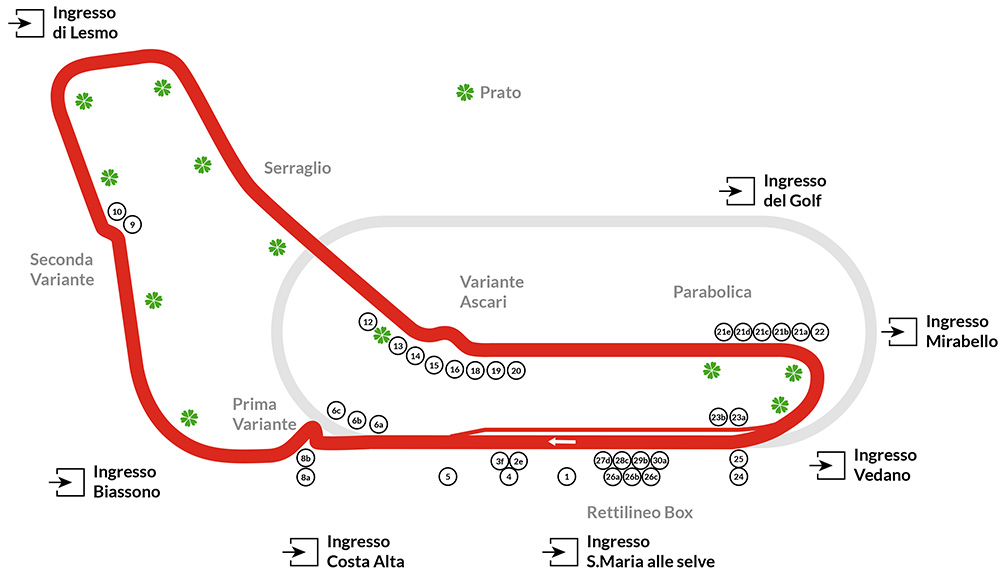
The stands
At the Autodromo Nazionale Monza it is possible to experience the races as a spectator from multiple points of view. To find your favorite place, you can refer to the following map.
The numbering of the stands follows this logic: the letter indicates the row, while the number indicates the seat. The first row at the bottom is row A, to then go up with the following letters. Seat number 1 is on the left (looking at the grandstand from the front) while the highest numbers are on the right.
- Central Grandstand n ° 1
- Bleachers Finish line n. 2e 3f
- Left Side Stand n ° 4
- Swimming pool grandstand n ° 5
- ABC High Speed Grandstand n ° 6
- External Grandstand First Variant AB n ° 8
- Secona Grandstand Variant n ° 9
- Roggia grandstand n ° 10
- Ascari Tre grandstand n ° 12
- Ascari Due grandstand n ° 13
- Tribune of the “Friends of the racetrack and park” Association n ° 14
- Ascari Uno grandstand n ° 15
- Ascari grandstand n ° 16
- Ascari ABC exit grandstand n ° 18, 19, 20
- Parabolic Side Grandstand ABCDE n ° 21
- Parabolic grandstand n ° 22
- Parabolic Grandstand AB n ° 23
- Vedano stand n ° 24
- Grandstand for the disabled n. 25
- Right Side Stand ABC n ° 26
- Bleachers Finish line n. 27D, 28C, 29B, 30 °
The Circuit
The Monza Circuit is known throughout the world as the Temple of Speed. Since its foundation in 1922, it has been constantly renewed in order to keep up with the needs of the motor world and to always offer great emotions.
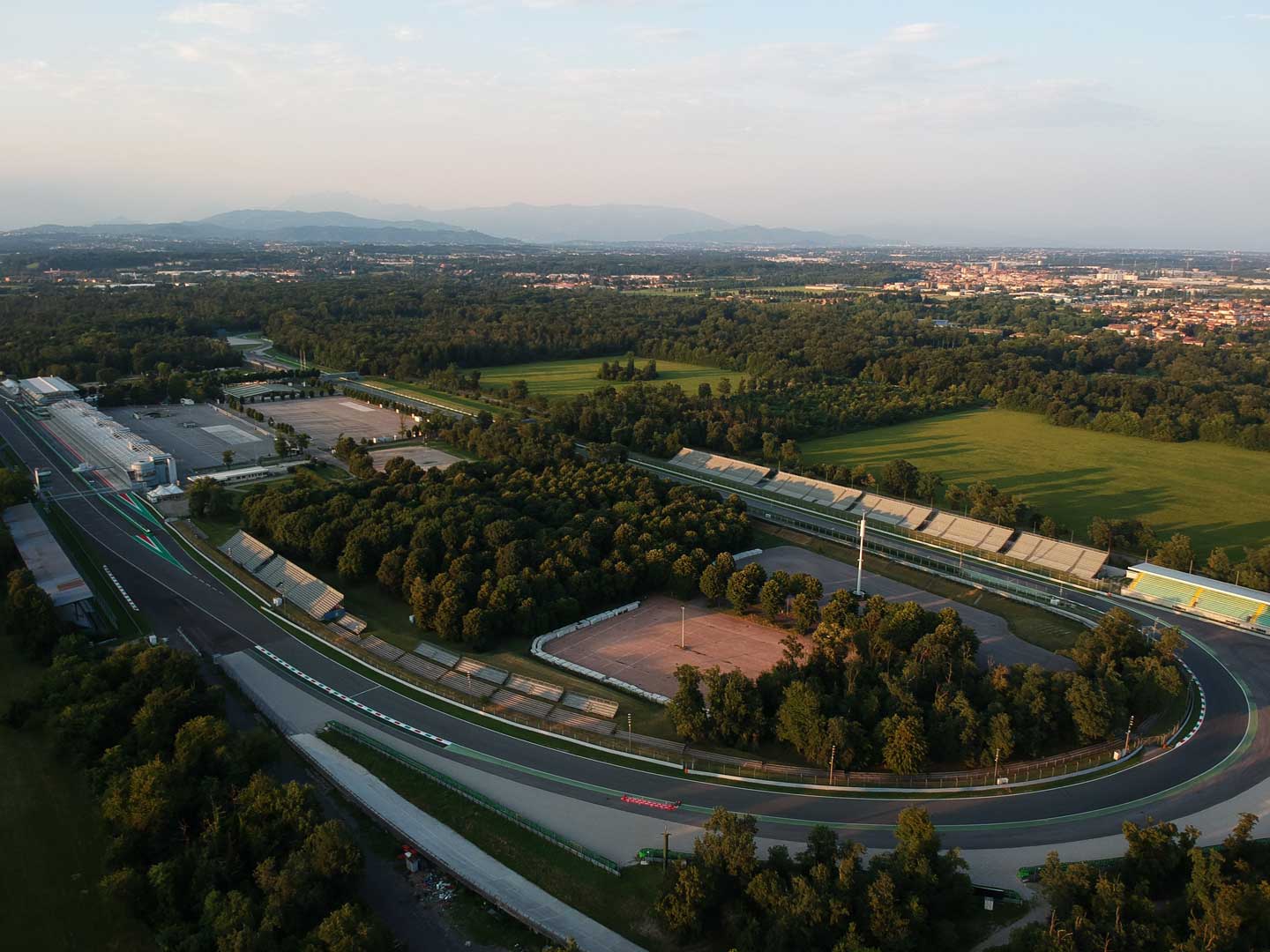
Coordinates
45°37'06" N 9°16'54" E
Length
5.793 m
Width
min 10 m - max 12 m
Track direction
Orario
Curves
7 destra / 4 sinistra
MAX Velocity
372,2 km/h
2005 — Juan Pablo Montoya su McLaren-Mercedes
Move the cursor over the interactive areas and discover the circuit and the services of Autodromo Nazionale Monza
Starting line
The starting straight runs from the end of Curva Alboreto (Parabolica) to the beginning of the First Variant and is 1194.40 meters long. For the races of the minor categories (Formula Junior) the so-called "Junior track" was used, now disused: it is a shorter circuit, which uses a section of the arrival straight, the opposite straight and the Curva Alboreto (Parabolica). The ring is closed by a slip road which, coming off the home straight about 200 meters after the pits, joins the opposite straight immediately after the Ascari chicane. The junction has three curves, the first on the right, the second on the left and the third again on the right. The length of the Junior track is 2405 meters.
September 13, 1953
At the last lap, Alberto Ascari leads ahead of Fangio and Farina. But at the Curva Parabolica the leader ends up in a spin, thanks to the presence of two lapped drivers. The accident eliminates Ascari's Ferrari and makes Farina lose positions, giving the go-ahead to Fangio for his first triumph at Monza.
September 5, 1971
5 single-seaters enclosed in a second fight for the victory in a sprint. Gethin wi
September 9, 1990
At the end of the 1st lap, Derek Warwick's Lotus crashes against the guardrail at the exit of the Parabolica. The single-seater capsizes and ends its crazy race upside down. The fear vanishes when the Englishman emerges unharmed from the wreckage and rushes to the pits to get into the reserve car and line up for the second start, after passing the medical checks.
September 12, 1993
A few meters from the finish line, Christian Fittipaldi's Minardi takes off after hitting his teammate Martini. He does some looping and lands on the 4 wheels, without consequences.
